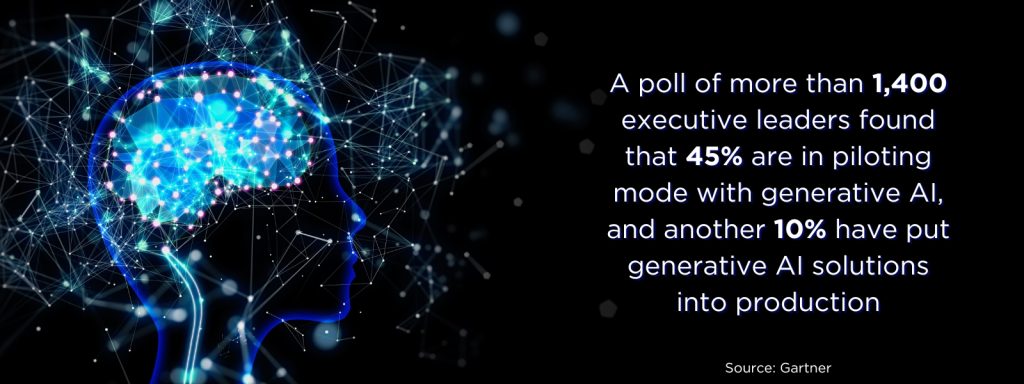Sometimes it is hard to look forward and know exactly where we are headed with technology initiatives, especially when there are so many different directions to head. But often, looking back can paint a picture of where we have been to give us the foresight we need to know where we should be heading.
Looking at the next big tech trend and who’s leading the technology charge to make it happen for the companies and the worker of tomorrow, we must understand the biggest tech trends of now.
We must identify the lessons we have learned in the past 12 months, and we must use this information to then lead the charge with generative AI (artificial intelligence), digital twin, Industry 4.0, quantum, AR (augmented reality) and VR (virtual reality), metaverse, machine learning, and so much more?
Consider just one big example: generative AI. We know adoption has soared in this area in the past 12 months. Gartner polled more than 1,400 executive leaders and found 45% reported they are in piloting mode with generative AI, and another 10% have put generative AI solutions into production.

These numbers are impressive, especially when you compare them to a poll from March and April 2023, which shows only 15% of respondents were piloting generative and only 4% were in production. The growth here in such a short period of time is huge—and of course this is only one example.
How will you help demystify the technology solutions that will drive innovation into the next decade? To have a better idea of how to answer this question, we polled a few experts. Let’s start by looking where we have been to know where we are going.
What were the biggest tech trends you noticed in 2023?
“Parks Associates notes 5 tech trends for 2023
- Enhanced Interoperability Across Industries
- Artificial Intelligence Integration
- Emphasis on Energy Efficiency
- Advancements in Networking
- Emergence of Smart Spaces

- Enhanced Interoperability Across Industries: There is an ongoing push for improved interoperability in all major industries, facilitating seamless communication and collaboration between diverse systems and platforms. This trend underscores the growing need for standardized protocols and interfaces to enable more efficient cross-industry integration.
- Artificial Intelligence Integration: Artificial intelligence is increasingly being integrated across various sectors, leading to transformative changes in how businesses operate and deliver services. This integration is not just enhancing efficiencies but also enabling new capabilities and business models, fundamentally reshaping industries.
- Emphasis on Energy Efficiency: There’s a growing focus on energy efficiency and the implementation of sophisticated energy management systems. This trend reflects a heightened awareness of sustainability issues and the need for smarter energy consumption in response to global environmental challenges.
- Advancements in Networking: Significant advancements are being made in networking technology, enhancing the capability of devices to connect, exchange data, and integrate across different home ecosystems. This progress is pivotal in creating more cohesive and responsive smart home environments, where various devices work together seamlessly.
- Emergence of Smart Spaces: The concept of smart spaces is gaining traction, particularly in multifamily, hospitality, and small-to-medium business sectors, where connectivity is increasingly central to operations. These environments are rapidly evolving into more intelligent and interconnected spaces, offering enhanced experiences and operational efficiencies through advanced technology integration.” – Elizabeth Parks, president and CMO, Parks Associates

“Generative AI (‘GenAI’) I think has made the largest impression in the minds of supply chain leaders. We are beginning to see meaningful progress in accessible use cases, such as ‘natural language processing’ for user-guide/help-manual/application navigation questions (essentially loading the software vendor’s existing documentation in a generative AI solution). Further extension of these capabilities will likely require development of more narrowly banded, and trained AI, that is more specific to each software vendor (at least in the near-term). These techniques (GenAI and NLP) may then be able to manage further activities such as parameter setting, scenario impact/trade-off analysis and report generation/manipulation, also driven from a natural language processing capability (e.g. ‘chat bot’ or ‘voice to text’ enabled solutions).” – Caleb Thomson, senior director analyst, Gartner Supply Chain practice

“Definitely generative AI with ChatGPT coming along in November 2022, it took everyone by surprise and democratized AI for the masses. Companies had to switch quickly their AI strategies, from thinking that they had a few years to implement it, to react quickly and start investing into how to integrate Gen AI into their business models and supporting their clients.” – Rod Fontecilla, chief innovation officer, Guidehouse
What were the biggest lessons learned?
“Adopting new technologies is a complex and time-intensive process. The IoT (Internet of Things ) markets, encompassing consumer, multifamily, and SMB (small-to-medium business) sectors, exhibit remarkable fragmentation and competitiveness. This landscape is continually evolving, with the emergence of new entrants and the strategic realignment of established players aiming to maintain and expand their market share.” – Elizabeth Parks, president and CMO, Parks Associates
“When I speak to leaders at the most mature organizations, or perhaps the organizations with the largest innovation budgets, I often hear of very meaningful efforts and progress towards enterprise supply chain data rationalization. This looks like migrating, what at times can be dozens of discrete, siloed, ERP systems that require separate support and maintenance to much more singular and global cloud ERP solutions. These efforts, along with others, toward developing more singular logical representations of supply chain data in something like an enterprise supply chain data-lake can set the foundation for further end-to-end supply chain visibility and analytics (as decision support) drive performance improvements.” – Caleb Thomson, senior director analyst, Gartner Supply Chain practice
“I think what was most impacting was the speed of adoption. Companies were not ready to let all their employees use these tools. However, these new tools are so powerful that if you are not using them, you are falling behind rapidly. So, the lesson learned is to embrace technology and come up with ways to manage the potential risk.” – Rod Fontecilla, chief innovation officer, Guidehouse
How can we take the lessons learned from 2023 and apply them in 2024?
“In order to capitalize on the potential of AI, and perhaps particularly GenAI in the near term, organizations need to be clearer about how they organize and provide continual validation for their supply chain data. There are very interesting and emerging opportunities to point ML (machine learning) solutions at the foundational problems of data availability and quality, and I think leaders who foster technology enablement for data governance within their supply chain will be best situated to realize further productivity gains through more exact and precise decision making (improving decision quality).” – Caleb Thomson, senior director analyst, Gartner Supply Chain practice
“If I read the tea leaves, I would say we are very close to AGI, or at least some form of Gen AI that can reasoned on its own and solve complex problems without human help. We need to get ready, embrace these technologies, learn to manage the risk, and re-skill the workforce rapidly.” – Rod Fontecilla, Chief Innovation Officer, Guidehouse
What was the biggest technology of the year?
“Generative AI is being infused within all industries and certainly is the most impactful technology in 2023.” – Elizabeth Parks, president and CMO, Parks Associates
“GenAI and Datalakes (e.g. Snowflake, Data-bricks) / Cloud Data Platforms (MS Azzure, AWS, Google Cloud Platform)” – Caleb Thomson, senior director analyst, Gartner Supply Chain practice
“I would say Gen AI hands down.” – Rod Fontecilla, Chief Innovation Officer, Guidehouse

Do you believe companies are more readily embracing gen AI in December 2023 than they were in January of 2023?
“Yes.” – Elizabeth Parks, President and CMO, Parks Associates
“We see GenAI as still in the ‘Innovation Trigger’ phase of our Hype Cycle for Supply Chain Strategy, and would see it become a technique that offers mainstream productivity gains across most organizations in 5-10 years; so to that extent, yes, they are more readily considering GenAI, but it may be some time until most are able to productively use GenAI.” – Caleb Thomson, senior director analyst, Gartner Supply Chain practice
“Absolutely, they have realized that if they don’t embrace them and re-skill their workforce the competition will do it and they will be left behind.” – Rod Fontecilla, chief innovation officer, Guidehouse
What comes next?
“The Internet of Things is ushering in an unprecedented era of service delivery across various environments, including consumer, multifamily, and small-to-medium business sectors. This evolution is increasingly influencing the commercial and small business realms, driven by consumer market demands for innovative technology. The consumer tech market, having cultivated a new level of familiarity and expectation around applications and services, is setting the stage for a seamless transition of these advancements into the enterprise and SMB markets.” – Elizabeth Parks, president and CMO, Parks Associates
“With ‘composability’ as a concept increasingly being applied to commercial supply chain solutions, I think that there is great potential for a ‘data-divide’, where the organizations that have laid the proper groundwork for more nimble and agile data use within their supply chain functions (particularly planning) will be better positioned to realize greater decision accuracy and higher levels of productivity from their internal resources. I think the constraint that may separate the winners from the losers may be availability of highly skilled resources that sit at the nexus of supply chain functional knowledge and data-science, to drive adoption and industry use of ‘composable’ applications within supply chain.” – Caleb Thomson, senior director analyst, Gartner Supply Chain practice
“I think, based on the OpenAI drama, the AGI is around the corner in some fashion. How governments and companies will use it will be interesting to see. The amount of disinformation next year (election year) will be enormous and will impact everyone, including how we vote and who do we elect. How can we trust any piece of information that comes out? Any video, any picture? They all may be fake.” – Rod Fontecilla, chief innovation officer, Guidehouse


